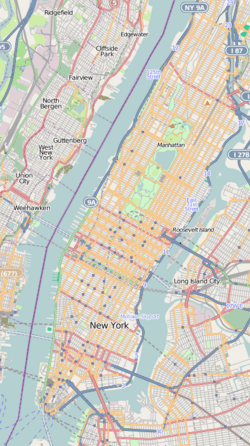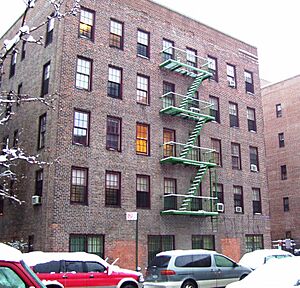First Houses facts for kids
|
First Houses
|
|

First Houses in 2011
|
|
| Location | 29-41 Ave. A & 112-138 E. 3rd St. Manhattan, New York City |
|---|---|
| Area | 1.2 acres (0.49 ha) |
| Built | 1935-36 |
| Architect | Frederick L. Ackerman |
| NRHP reference No. | 79001602 |
Quick facts for kids Significant dates |
|
| Added to NRHP | December 18, 1979 |
First Houses is a special group of apartment buildings in Alphabet City, a neighborhood in Manhattan, New York City. It was one of the very first public housing projects built in the United States. Public housing means homes built and managed by the government to provide affordable places for people to live. First Houses was recognized as a New York City and National Historic Landmark in 1974 because of its important history. The New York City Housing Authority takes care of these buildings today.
Contents
What Are the First Houses?
First Houses is made up of 122 apartments. These apartments have either three or four rooms. They are located in 8 buildings, which are four or five stories tall. You can find them on the south side of East 3rd Street between First Avenue and Avenue A. They are also on the west side of Avenue A, between East 2nd and 3rd streets. This area is part of the Alphabet City and East Village neighborhoods.
The History of First Houses
Building New Homes in the 1930s
First Houses got its name because it was one of the first public housing projects ever built in the United States. The first people moved into these homes on December 3, 1935. Before First Houses was built, there were old, crowded apartment buildings called tenements on the same spot. These tenements were from the Victorian era.
The city's new Housing Authority started its very first project by clearing these old buildings. They finished building First Houses in 1936.
From Old to New: A Big Project
Originally, the plan was to fix up the old tenements. The idea was to tear down one out of every three buildings to create more space, light, and fresh air. However, the architect Frederick L. Ackerman and his team soon found out that the 19th-century tenements were too old and weak to be rebuilt.
So, they decided to tear them all down and build First Houses completely from scratch. They even reused some of the old foundation parts. The project also reused bricks and gave jobs to many people who needed work, paid for by the government.
Ackerman designed the new apartment buildings with entrances at the back and open courtyards. This design allowed more light and air into the homes than the old tenements. The open areas behind the buildings had cobblestone paths, playgrounds, trees, benches, and even sculptures for the people living there.
Why First Houses Mattered
Even though First Houses cost more money than expected, the head of the Housing Authority, Langdon Post, believed it was worth it. He said it proved that public housing could actually be built.
He also noted that it helped the Housing Authority issue special bonds to pay for land. Important people like Vincent Astor and Bernard M. Baruch bought these bonds, which were the first of their kind.
Winning the Right to Build
Another big win for First Houses was that it helped the Housing Authority test its power to take land for slum clearance. Slum clearance means tearing down very old, unsafe, or unhealthy buildings to make way for new, better ones. This power is called eminent domain.
The owner of two old tenements on East 3rd Street argued that taking his property, even with payment, was against the rules of the United States and New York State. However, the New York State Court of Appeals, which is the highest court in the state, decided that the Housing Authority could take private property.
The court said that if a situation in the state is a serious danger to public health, safety, or general well-being, the government has a duty to use whatever power is needed to fix it. This ruling was very important for future public housing projects.
See also
 In Spanish: First Houses para niños
In Spanish: First Houses para niños





